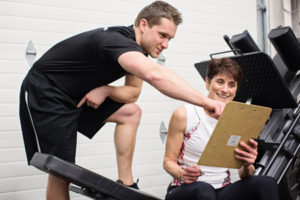High blood pressure (hypertension) is very common in the United States: approximately 1 out of every 3 adults (67 million) have high blood pressure. High blood pressure increases the risk for heart disease and stroke, which are the two leading causes of death for Americans. Luckily, there’s a free way to treat high blood pressure without those pills.
EXERCISE…! Exactly what you wanted to hear right? Probably not, but it’s one of the most powerful medicines (yes, exercise is medicine). We often think of exercise as a way to look good and improve our appearance, but the benefits are so much greater.
What Is Blood Pressure?
Blood pressure is the force that blood exerts on the walls of arteries as it flows through the body. Blood pressure is determined by two measurements: the top number (systolic) is the force exerted on arterial walls during the heart’s contraction phase; the bottom number (diastolic) is the force exerted during the relaxation phase. Normal blood pressure is considered less than 120/80, pre-hypertensive is 120-139/80-89, and hypertensive is 140+/90+.
What Type of Exercise?
Numerous research studies support aerobic exercise as a means to reduce blood pressure. While the benefits of aerobic exercise are clear, the benefits of resistance training to lower blood pressure have been debated. As the body of research grows, however, it’s becoming evident that resistance training also plays a role in blood pressure reduction. A well-rounded program consisting of aerobic exercise and weight lifting is highly recommended. Individuals with hypertension need to make sure they follow these key tips for safe training:
1. Inform your fitness practitioner of any drugs you are taking. Some drugs may alter heart rate response to exercise.
2. Properly warm up to avoid sharp increases in blood pressure.
3. Allow for adequate cool down, this slowly returns blood pressure to resting levels.
4. Don’t hold your breath during exertion as this may cause sharp increases in blood pressure.
How Much and How Long?
Intensity and duration of exercise depends on your fitness level and current blood pressure. A minimum of 30-60 minutes of exercise, at a moderate intensity (40-70% max heart rate), 3-5 days per week is currently recommended for individuals with high blood pressure. Any restrictions/medications from your doctor must be communicated with your fitness practitioner before engaging in an exercise program.
Prevention
Even if you aren’t hypertensive, exercise is a key component in maintaining normal blood pressure. Higher physical activity levels have shown an inverse relationship to the development of hypertension. More exercise equals less risk of developing hypertension.
Conclusion
Hypertension is associated with increased risk of stroke and heart disease, the two biggest killers in the United States. While some cases of blood pressure do require medication, lifestyle modifications should be used in conjunction as much as possible. If you currently have high blood pressure, talk to your doctor about starting an exercise program. If your blood pressure is normal, make sure you use exercise to prevent hypertension later in life.
About the Author:
-

Michael Stack is the founder & CEO of Applied Fitness Solutions and Frontline Fitness Pros. He is a faculty lecturer for the University of Michigan’s School of Kinesiology. He is also the creator and the host of the Wellness Paradox Podcast, produced in conjunction with University of Michigan.
Michael is an exercise physiologist by training and a health entrepreneur, health educator, and fitness industry advocate by trade. He is dedicated to enhancing the standard of practice of, and advocating for, fitness and wellness professionals to ensure they become an essential constituent in the healthcare delivery system.
With a career spanning over three decades in fitness, health, and wellness Michael has a deep knowledge of exercise physiology, health/wellness coaching, lifestyle interventions to mitigate chronic disease and leadership. He is credentialed through the American College of Sports Medicine (ACSM) as an Exercise Physiologist (ACSM-EP), Exercise is Medicine practitioner (ASCM-EIM), and a Physical Activity in Public Health Specialist (ACSM-PAPHS). Michael is a National Strength & Conditioning Association (NSCA) Certified Strength & Conditioning Specialist (CSCS), and a CDC Diabetes Prevention Program (DPP) Lifestyle Coach.
Michael received his undergraduate degree from the University of Michigan’s School of Kinesiology in 2004 and is currently a Master’s of Public Health (MPH) candidate at University of Michigan, with a specific concentration in health behavior and health education.
Michael is a board of directors’ member for the Physical Activity Alliance and Michigan Fitness Clubs Association. He sits on the University of Michigan’s School of Kinesiology Alumni Board of Governors. Michael is an expert curriculum reviewer for the American College of Lifestyle Medicine. Finally, he is a member of the executive leadership team for American Heart Association’s Heart Walk.
Michael lectures nationally for several health/fitness certification and continuing educations, including; IHRSA, the Medical Fitness Association, the National Strength & Conditioning Association, and SCW Fitness.

